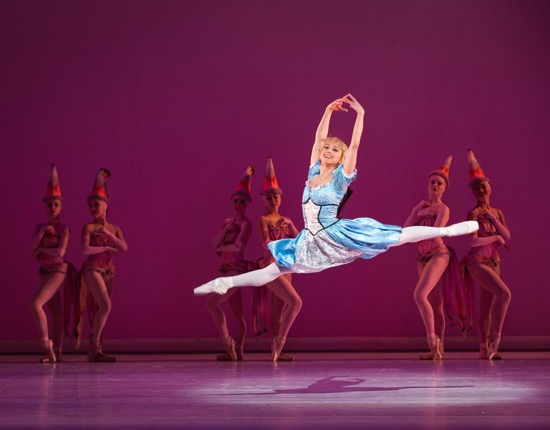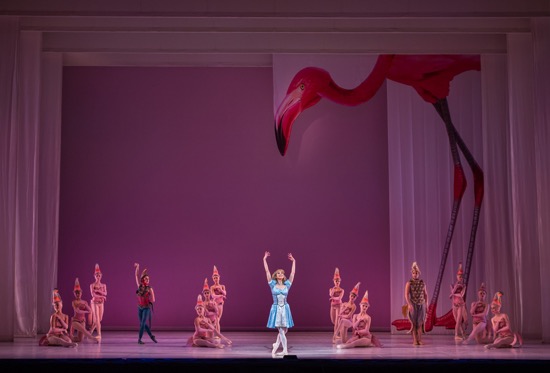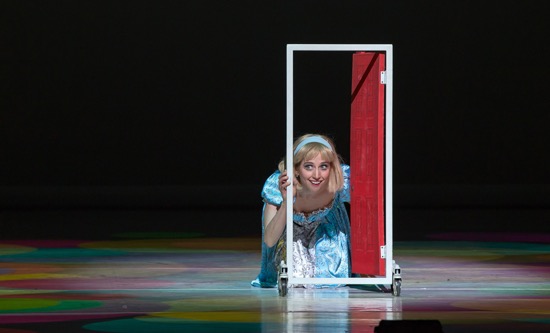
One of our goals at 4dancers is to provide you with solid advice that you can put to use in your dance life. We asked Colorado Ballet ballerina Sharon Wehner if she would share some of her best advice for dancers, and she compiled a great list for us to share with you here…enjoy!
by Sharon Wehner
Listen to your teachers, but use your brains too!
This might seem like an obvious piece of advice, but because dance, particularly some techniques like Graham or classical ballet come steeped in tradition, there is always an aspect of “shut-up and dance” when it comes to being in the studio. This is both good, and bad.
As a student of anything, whether math, Spanish, or dance, it’s crucial that you be able to trust your teachers. Once this trust is established, a student’s job is to listen and absorb the teacher’s information, and then apply it. The more trust and respect established, the more a dancer can get past their own limits, fears or hesitations and improve technically and artistically. But unlike your academic teachers, there are no standards set for who can teach dance. Anybody can open a dance studio. Of course there are a myriad of training courses and degrees with testing and accreditation, which certainly lends credibility to a teacher’s qualifications, but a piece of paper does not necessarily guarantee a great teacher. There are amazing teachers who have no degrees. On the other hand, there are also amazing former professional dancers with years of experience who are not the greatest teachers.
So as a young dancer goes through his or her training years, it is a good idea for both parents and students to evaluate teachers based not only on their experience and credentials, but also on what makes sense for that student. As mentioned above, the best teacher-student relationship consists of inherent trust and respect. Because dancers are often asked to work through feelings of discomfort and fatigue, both emotionally and physically, it falls upon the shoulders of a teacher to gauge when this push is necessary for a dancer to improve, and when it crosses the line into “too much.” And again…every dancer and student is different. Some people thrive on stern discipline, while others need a softer hand. But either way, it is important that a dancer be able to balance listening to their teachers with complete trust, while simultaneously being able to think for themselves, and pay attention if they feel that a teacher is crossing that line.
Know your learning style.
In the same vein of the advice above, it’s good for a young dancer to explore and eventually gain an understanding of how they learn best. Some dancers are visual, some are more visceral. Some pick up movements and counts instantly, others may take more time. But just because you don’t pick up choreography as quickly as your friend, that does not necessarily mean that you are an inferior dancer, or a less intelligent dancer.
I can speak to this from my own experience. I have learned that it takes me more time to process information, and that I am a more experiential learner, rather than visual. This used to frustrate me to no end. Despite my best efforts to become a faster learner, I have found that the best tactic is to stop fighting my process, and to work with it with both understanding and intelligence. I know that I may need to spend a little extra time before or after rehearsal reviewing choreography and making sure that it is really “in” my body.

Be as objective as possible about your strengths and weaknesses.
Because our dance is intertwined with our hearts and minds, it is so easy to take everything personally! When we receive corrections, we have the option to view them as criticism or as an invitation to improve. Time in the studio is always an opportunity for growth, even those times that feel tedious and hard—especially those times.
The mirror, your classmates, and your teacher are all integral parts of your journey as a developing dancer. It’s completely understandable that we can lose this perspective. Remember that constructive criticism is meant to be just that—and remember that a note given about your dancing is about your dancing, not you as a human being. Most dancers have no problem seeing their faults, and it can spiral into a hole of frustration, and even depression. That is when it is especially necessary to be objective about the flip side of the coin—and recognize your strengths.
On the days that you feel like your teacher is “picking on you”, your friends are all improving and you’re not, and the reflection in the mirror is a massive ugly duckling—those are the days to step back, take a deep breath, and acknowledge three things that you like about yourself and/or your dancing. This may seem simplistic, but the truth is that every dancer has qualities that are beautiful. If you can’t see them in yourself, ask your closest friend for help. Then try to harness any emotions of frustration into a positive fire that propels you to improve your weaknesses so that all your strengths can shine even brighter!
Realize that every body is unique.
Just as you have special strengths and weaknesses, you have a body that is expressly yours, different from your peers. Your teachers should be experts in working with all sorts of different bodies, so hopefully they are able to guide you in the best ways to work with all your beautiful quirks. Knowledge is power, so when you know your body has certain challenges—tight hips or loose ankles, for example—the best approach is to be aware, and then be proactive. These days, there are so many smart and safe ways to “change” our bodies. Dance-based conditioning, as well as cross-training with Pilates, yoga, Gyrotonic exercises, cardio, etc…all these are wonderful supplements to studio work to progress past our body’s limitations. Dancers love to compare their bodies to their friends, and we usually want what we don’t have. While this is normal, try not to be obsessed with comparing your body to others. Just as with our strengths and weaknesses, the most productive way to deal with our body’s limitations is to recognize them, do what we can to improve, accept the things that cannot be changed (height, for example), and then lovingly appreciate how much our bodies do for us!
Feed your body wisely.
How and what you put into your body directly effects your performance and recovery. This should be obvious, but dancers are notorious for fueling with junk, or under-fueling in general. My teachers used to compare a dancer’s body to a car—when you maintenance it well and “feed it” proper gasoline and oil, it runs efficiently and hangs in for the long-haul. And of course, the opposite is also true. There is a lot of nutritional information out there, so be wary of fads and know that what works for some people may not work for you.
Part of knowing your body is paying attention to how well it functions with certain foods and beverages, and how much water and electrolytes you need to keep your muscles hydrated. As you learn more about nutrition, always consider the source! When you have to write a paper for school, your professor expects you to use reliable, educated experts as sources. Better to take nutritional advice from a nutritionist than a random web blog, a Facebook advertisement, or even your best friend. In addition, although dance puts a premium on aesthetics and looking good in the costume, your ultimate priority should be health and function. Never let anyone, even a trusted teacher, convince you to do harmful things to your body in order to lose weight or fit some sort of external mold! It does no one any good to be thin, but weak or riddled with injuries.

Don’t be afraid to try new things.
Being a student means being receptive to new concepts and ideas, even ones that seem far fetched and ridiculous. There were a lot of classes I felt “forced” to take as a young dancer, which I thought were unnecessary. Then, twenty years down the road, I found myself using that information both as a professional and as a teacher. Getting out of our comfort zones is a part of life, and the more we can do it, the more opportunity we have to expand. Even when we no longer call ourselves a “student,” even when we are professionals, or teachers—we can still put ourselves in the position of a student.
When being confronted with challenges, trying new things for example, give yourself time to go through a “yucky” phase. In this day and age, we are so used to instant gratification, and instant results. There is very little patience for process. But sometimes the process is where the gold is. Dance is a physical art form, and the physical body often needs time to catch up with our intellectual and emotional ideas. We are constantly laying down new neural pathways in the body, and sometimes old pathways must first be erased, and then replaced. This takes practice, exploration, and above all, patience! For many of us, it means going through a period of discomfort. For me, it’s more like a period of total frustration, fear of never “getting” it, and feeling like a complete clumsy idiot! If you find yourself in this place, know that you are not alone, and you are just in the middle of a necessary growth period.
Outright failure is part the process too.
There will be times that you seem to hit a wall, or get a lot of “No’s” from the universe. You are cut in an audition, you can’t master a piece of choreography or technique, you have a bad performance, you get injured. Let’s face it, these times just stink. It’s healthy to feel sad, frustrated, and defeated, and I believe it’s important to let yourself feel these emotions. Dancers are, after all, human beings! But when you’ve finished having a good cry, or two–or three–remember that all the great leaders and innovators in history had many failures from which to learn from. Think of the “No’s” as road signs pointing you in the direction of “Yes”. We have all heard the proverb about a door closing and a window opening. We can learn so much from the times we miss the mark. Try to be curious about what actions or decisions would have created a better outcome, and then try those next time. And if that doesn’t work, try something else, and repeat… Failure is always an opportunity to learn, if you want it to be. There is a Japanese proverb: “Fall seven times, rise eight.” The important thing is to rise.
Don’t forget about balance.
Dancers are notoriously obsessive. And the truth is that it does take an extraordinary amount of dedication and determination to thrive as dancer. Long hours in the studio, sweat and hard work are all part of the process. But remember that our physical bodies also need rest in order to heal and recover. Our intellectual selves need other kinds of stimulation to contrast with choreography running in our heads. Our emotional selves need life experiences outside the studio to feed our souls. Time away from the studio, from dance media and YouTube—this time shapes our voices as human beings, and ultimately makes us better artists.
Lastly, don’t forget to enjoy yourself!
Dancers can get so caught up in their dramas, nerves, competition, hard work, etc…it’s easy to lose sight of why you started dancing in the first place. Every dancer has a place within themselves that connects to dance in a unique and personal way. It can be as simple as feeling good, and as esoteric as feeling God. But whatever your reason is, try not to let all the other “stuff” get in the way of that connection. Dancing will always be a part of your life and who you are, whether you are a student, a professional dancer or a rocket scientist who just likes to dance.
Above all, embrace this!
Colorado Ballet performs ALICE (in wonderland) through February 28th, 2016 at Ellie Caulkins Opera House.

Contributing writer Sharon Wehner is originally from San Jose, California. She trained with Jody White and David Roxander, San Jose Dance Theatre, San Francisco Ballet and San Jose/Cleveland Ballet. Ms. Wehner joined Colorado Ballet in 1995 and was promoted to Principal in 1999, and in the last 20 years, has performed many lead roles with the Company. These include Kitri in Don Quixote, Giselle in Giselle, Odette/Odile in Swan Lake, Medora in Le Corsaire, Aurora in The Sleeping Beauty, Swanilda in Coppelia, Mina in Dracula, Juliet in Romeo & Juliet, the Cowgirl in Rodeo, the Sugarplum Fairy in The Nutcracker, Cinderella in Cinderella, Esmerelda in The Hunchback of Notre Dame, Titania and Helena in A Midsummer Night’s Dream, Second Violin in Balanchine’s Concerto Barocco, the Principal couple in Balanchine’s Stars and Stripes, Rubies, and Theme and Variations, Antony Tudor’s Leaves are Fading, and Twyla Tharp’s In The Upper Room. She has been honored to have solos and pas de deuxs created on her by choreographers Val Caniparoli, Edwaard Liang, Mathew Neenan, Christopher Wheeldon, Darrel Grand Moultrie, Dwight Rhoden, Jessica Lang, Brian Reeder and Toru Shimazaki.
In addition to Colorado Ballet, Ms. Wehner has also performed with The Washington Ballet, Oakland Ballet and Amy Seiwert’s Imagery. She has also been a guest artist at the Vail International Dance Festival, in Japan in the Aoyama Ballet Festival, and the National Ballet of Japan’s Golden Ballet Co-star. Sharon enjoys teaching dance to all ages and abilities, particularly Dance for Parkinson’s Disease.





[…] 2. A Ballerina’s 8 Top Tips For Dancers […]